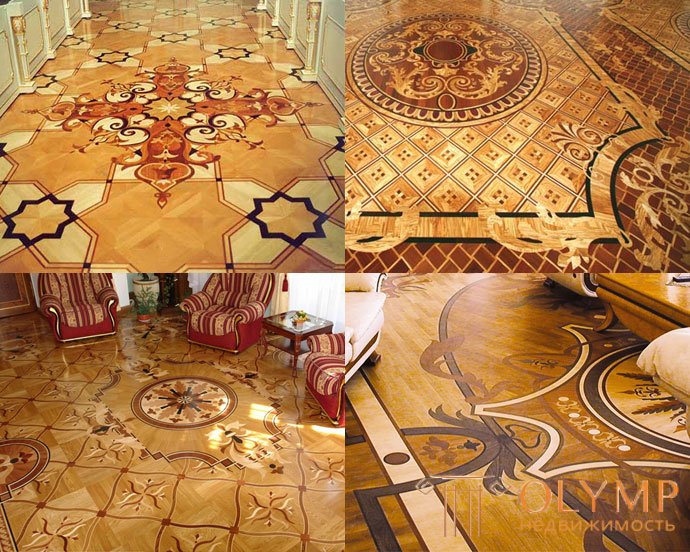
For the manufacture of parquet used wood species growing in mixed forests - birch, maple, oak, beech, ash, as well as wood species growing in the tropics - merbau, wenge, mahogany and bamboo, which technically is not a tree, but often used for laying floors.
First you need to determine in which premises and in what conditions the parquet will be laid , and then, based on the budget, the characteristics of the wood and the types of parquet, the subjective opinion to determine which parquet should be purchased .
The parquet purchased must be marked by the manufacturer and the country where it is made. Attention should be paid to the humidity and geometry of the parquet being sold. If necessary, humidity can be checked with a hygrometer (which any reputable parquet seller should have) if there are doubts as to the quality of the goods offered. Optimum humidity 8% ± 2%. The simplest method for checking the geometry of a parquet is to fold two dies in such a way that a right angle is obtained when docking. Inside the resulting corner is a square of parquet of the same size. With an ideal parquet geometry, the width of the resulting square is equal to the length, which means that the plate geometry is at a sufficient level and has not changed during storage and drying of the parquet.
The following parameters shall be indicated in the marking of the parquet: wood species, dimensions and category of sawing wood. By production, parquet planks are sorted by cut, presence or absence of knots, sapwood (young layers of wood), as well as by texture and color. The main ways of cutting wood are radial and tangential . Radial sawing is made along the radius of annual rings, through the middle of the trunk, and tangential cutting of wood - tangentially to annual rings. It is possible to distinguish the types of cutting by annual lines: longitudinal parallel lines prevail at radial cutting, and wavy at prevailing at tangential cutting.
 1 - tangential cutting, 2 - radial cutting
1 - tangential cutting, 2 - radial cutting 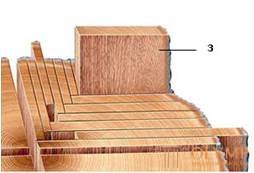 3 semi radial cut
3 semi radial cut 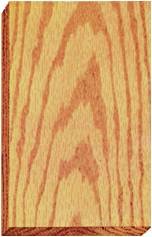 Tangial cut
Tangial cut 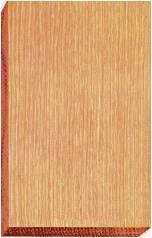 Radial Cut
Radial Cut
The current regulatory and technical base (GOST 1985) provides for two categories (classes) - A and B (highest and first). Many manufacturers use the German standard (DIN 280), according to which the parquet is in three categories: Natur (N) is natural; Gestreift (G) - striped; Rustikal (R) - heterogeneous, knotty. In Austria, another category is added to these categories - Exquisit (Е) - elite. For the floorboard provides a more simple classification:
- Prime - practically has no knots, but admits the presence of eyes;
- Selekt allows healthy knots;
- Rustik can have any knots, even partially knocked out.
In some cases, manufacturers add their own labeling.
Parquet properties are determined by the quality and grade of wood, the hardness of wood and its moisture. Accordingly, hardwood parquet is more practical than soft parquet. Usually, oak hardness is used as a reference unit of measurement. The main properties - resistance to moisture, the amount of deformation and wear resistance directly depend on the cutting method. The radial cut parquet has these indicators higher. The best parquet is parquet, which combines the hardness and stability of geometry. By the way, the optimum humidity of the room for storage, laying and operation of parquet - 45 ~ 6o%
The parquet dies are sorted by the number of knots, the cutting method, the presence of areas called sapwood (the areas on the outer part of the logs with low density, lighter and friable).
The most expensive and stable is sorted radial parquet. This is the highest grade parquet with a smooth texture, free from wood defects and mechanical damage.
- Select - top grade parquet without selection for cutting.
- Nature - the highest quality parquet, also without selection for cutting. It allows sapwood (no more than 20%) and knots with a diameter of no more than 3 mm.
- Rustik - parquet of the first quality category. Allowed color drops, sapwood, knots with a diameter of 5 mm.
Usually, 7% of the select is obtained from one log, 78% is natural and the rest is rustic. However, it should be borne in mind that the selection of parquet - the concept is very conditional: for different manufacturers and suppliers with the same grade name, products may differ markedly in quality.
Varieties of parquet:
- block parquet - wooden planks (dies, riveting) with overall dimensions: length 200-500 mm, width 40-70 mm, thickness 14-22 mm. On the side and end faces, as a rule, there are spikes and grooves. The durability of the piece parquet is determined by the thickness of the working layer (the distance from the front surface of the parquet plank to the spikes). For example, a parquet with a thickness of 15 mm is 8 mm. On the lower side of the slats, as a rule, there are slots that relieve the internal tension of the wood fibers and do not allow the parquet to warp. Difficult styling, increased requirements for the base, but parquet is a style.
solid board - has the following dimensions: length 2000-2500 mm, width 120-200 mm, thickness 18-22 mm. On the side and end faces of the boards there are spikes and grooves for assembly. The coating may be varnish or oil. The advantages of the array are obvious, but its behavior may be less stable than the three-layer structure.
shield parquet is a multi-layer structure consisting of a coniferous substrate and a face layer of valuable wood species. As a rule, shields have a square shape (length 400-800 mm, thickness 20-40 mm, working layer - 5_15 mm).
parquet board - has a design similar to a shield, but differs in size: length 2000-2500 mm, width 180-200 mm, thickness 14-20 mm. On the side and end faces there are spikes and grooves for assembly. The main advantage of parquet and panel parquet is the speed of installation and relative ease of installation.
The finishing coating can be produced both in the factory and applied after laying the floor. Both methods have their disadvantages and advantages. Oil coating is considered more environmentally friendly, but requires frequent updating of the coating - about once every three months. Lacquer in terms of coating care requires less attention.
The main methods of laying parquet: floating (except for piece parquet), gluing boards across the entire area to the base, fixing nails to black wooden floors and laying on logs.
Floating method - gluing parquet with each other along the thorn-groove connection, without fixing to the base. The method is considered one of the most technologically advanced, although the adhesive gives greater rigidity. Gluing to the base is recommended for laying parquet or artistic parquet. The method requires a particularly smooth and durable dry basis.
For laying massive boards and some exotic breeds use only two-component polyurethane glue. Otherwise deformation due to internal stress is possible - other adhesives will not hold. The alternative is a floor laid using special technology on adjustable lags, on top of which two layers of plywood are put. Another way to build - castle, or "click" connections. Parquet just "clips" dies to each other. Very fast way, assuming the same rapid analysis of the floor if necessary.
Combinations of parquet with other materials (ceramics, metal, glass, mother-of-pearl ...) no longer surprise anyone. In addition, modern technology allows non-standard use: parquet can be put in places that seem to be the most inappropriate: in the bathroom, on the outdoor terrace, in the garage, and even on garden paths. In such extreme conditions, teak behaves best because it has a unique wood structure containing a large amount of essential oils and adhesives. This allows him not to be afraid of dampness and direct sunlight. However, exclusive methods of drying will allow even a capricious beech to be exemplary: for example, professional basketball is played on a beech surface. There are technologies that allow the use of parquet with a system of underfloor heating. But such shocks will make only specially designed for this flooring.
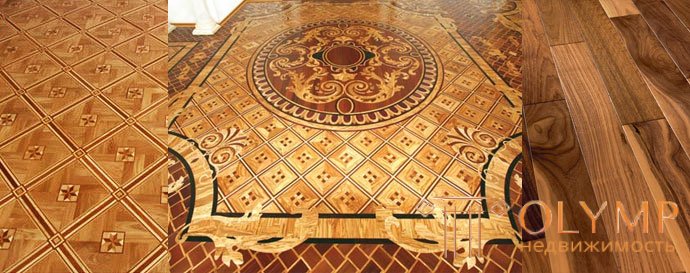
Parquet - wooden flooring, consisting mainly of natural wood. In this article we will tell about the types and types of flooring, their features.
Block parquet is the most common type among its fellows. The coating of parquet consists of strips with grooves and ridges (spikes), which, connecting to the castle, form a single structure. Production material: solid wood.
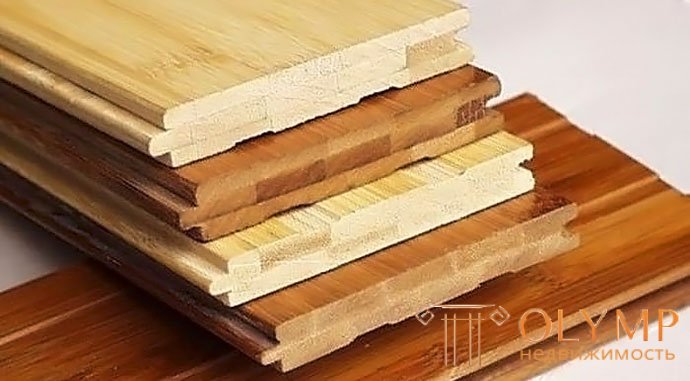
The thickness of the slats is in the range of 15-22 mm, length reaches 50 cm, thickness 7.5 cm.
Piece parquet has quite good advantages over other types of coating:
Classification of piece parquet according to the cut of drawings:
The name of the mosaic look of parquet was due to the fact that in panels of 40 × 40 or 60 × 60 cm there is a set of parquet planks of different shades. Thickness of slats 8-12 mm. The finished parquet floor of such panels will be an interesting mosaic (you can also lay out the pictures).

The front side of the parquet is protected by a special paper that must be removed after laying the entire coating. Soundproofing can be glued to the underside.
According to the profile of the grooves (edges) and methods of attachment to the base, the parquet floor can be of 4 types:
The composition of panel parquet includes 2 layers. The first layer is directly a square shield of planks or fiberboard, the second layer (front) is small strips of solid wood. The dimensions of the shields can be up to 80 × 80 cm; thickness is 15-30 mm. The front layer is varnished.
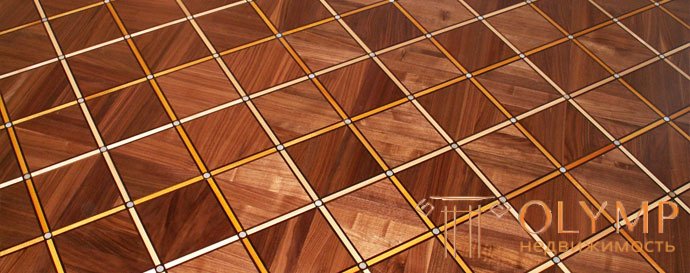
The main pattern on the shield parquet is a square or its derivatives. In some cases, you can make a picture to order.
Types of the bases of panel parquet:
Types of front parquet paneling:
This is the most expensive parquet, which is what its name says (it is also called artistic parquet). A palace may have multiple bends and weaves to create not just a pattern on the floor covering, but a real work of art. Naturally, such a parquet can afford wealthy people with large living space. To make the floor of the palace flooring at the whim of the host, you need to make all sorts of measurements. Fortunately, there is already high-precision equipment that allows you to create different versions of parquet strips for the construction of a large floor from the palace parquet.

When creating a palace artistic parquet, several dozens of tree species can be used, which makes the coating absolutely unique in its composition.
For a palace parquet, you need to intelligently select wood species, so that changes in humidity and temperature affect each species without disturbing the others.
A massive parquet board consists of a solid (and valuable, therefore more expensive) piece of wood. Massive parquet has to be the elder brother of piece parquet (it also has grooves and ridges (spikes) for fixing in the process of laying). In fact, the difference between them is only in size: width is from 8 cm, length can reach several meters, thickness is from 15 mm.
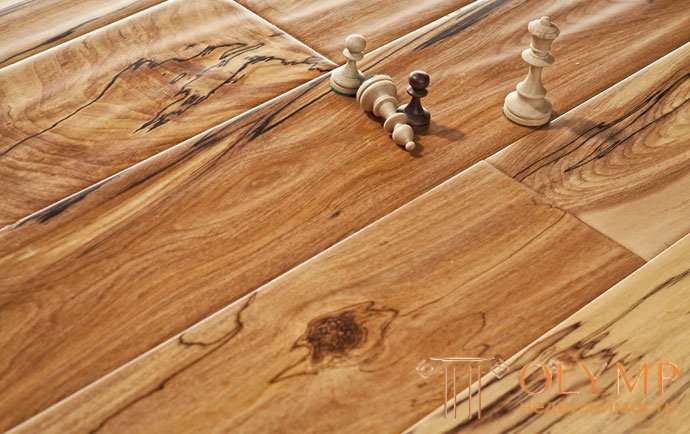
The floorboard is called a three-layer, because it consists of three pieces of natural wood. The fiber layers are transverse to each other, so the board withstands temperature and humidity drops well. The lower layers consist of conifers, and the top - from the price of durable wood.
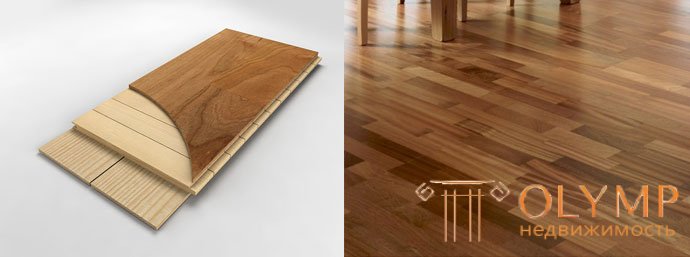
The top layer can be solid, and can consist of 3 - 4 bars to create a more mosaic shade of the floor covering.
The dimensions of a three-layer parquet board: length 120-27 cm, width 13-21 mm, thickness 7-23 mm. As a rule, the parquet flooring is immediately varnished during production.
Laminated parquet consists not of natural wood, but only imitates its structure.
Laminate consists of 4 layers:
The total thickness of all these layers can be from 7 to 11 mm.

Multi-piece parquet is called pronto-parquet. High quality wood species are used for its manufacture. Especially for the top layer, which is made of oak, walnut, mahogany. The process of creating a multi-piece parquet takes time (up to 7 months): high-tech heat treatment contributes to high-strength wood. Then the wood is polished. Pronto-parquet is either lacquered (it costs 2 times more), and non-varnished.
The parquet board consists of several layers of natural wood carefully glued together. An attractive look to the parquet is attached to the drawing applied to the top layer of the product. The bottom layer of the board has a thickness of 1-2 mm. For its production using pine or spruce plywood. Next is the middle layer, made of narrow pine or spruce plates (lamellae). They stick across the bottom layer. This design gives the flooring additional strength.
From above the front layer consisting of valuable breeds of wood is glued. In its manufacture using beech, ash, oak. The thickness of the top layer is 3-4 mm. On the front of the parquet is applied a protective coating in several layers. Due to the fact that the middle lamellae are located across the upper and lower layers, a solid construction is created.
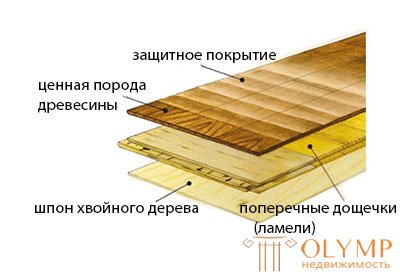
The structure of the floorboard
Parquet advantages:
Parquet disadvantages:
Laminate consists of several layers, the top of which is covered with foil or furniture foil. The coloring of the upper layer affects the appearance of the product. It can imitate ceramic tiles, wooden texture, stone. Laminate flooring is a multi-layered panel with a length of about one meter and a width of about 20 cm. The bottom layer is made of water-resistant resin-impregnated paper or thin plastic. It gives the structure rigidity and stability. The middle layer - the basis of chipboard or fibreboard. In addition to the additional strength of the structure, it gives elasticity and moisture resistance.
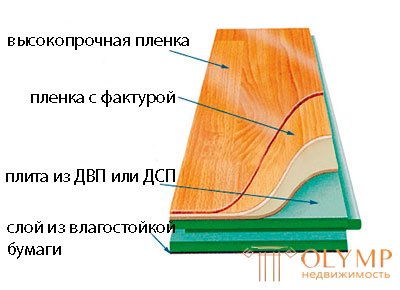
Laminate structure
The next layer consists of a plastic film or foil with a printed texture. Due to this, there is a laminate imitating wood, marble, carpet. A laminate is applied over the last layer - a high-strength non-electrifying film.
Advantages of laminate:
The disadvantages of laminate:
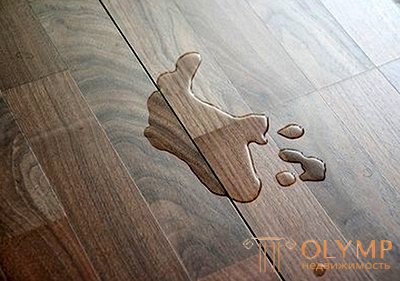
The film covering the top layer of the laminate reliably protects the coating from moisture
Definitely answer the question: “what is the best parquet or laminate flooring?” Is impossible. Both coatings are easily mounted using a "lock". It all depends on the specific situation. It is necessary to focus on each case separately.
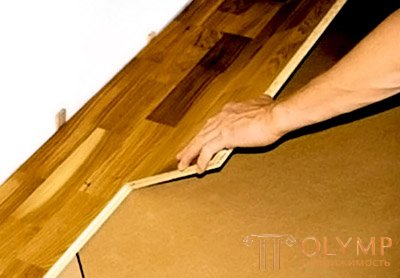
Installation of flooring using the "lock"
If you need to choose a floor covering for a room with a high cross, it is better to choose laminate. The impact resistance of this coating is one and a half times higher than that of parquet. Abrasion resistance is also not the last argument in the choice of laminate. The same characteristics speak in favor of the laminate if the floor is chosen by pet owners.
Parquet will not be able to withstand the onslaught of animal claws for a long time. In other cases, it is more profitable to choose parquet for domestic floors. After several years of use, it can be ottsiklevat, opened with varnish and the floor will look like new. Another difference from the laminate flooring in its appearance. In rich and solid interiors, flooring looks much more sophisticated than laminate.
Undoubtedly, the floorboard keeps heat better. It can be laid directly on the concrete pavement. But if the choice fell on the laminate heat problem can be easily solved. It is enough to install a floor heating system or to insulate floors.
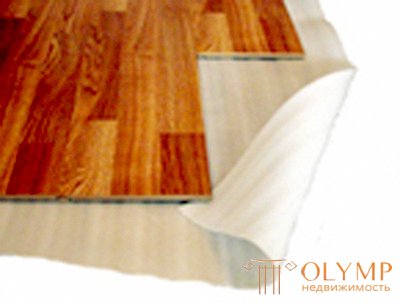
Laminate insulation using isolon
Not all houses and apartments are provided with modern ventilation system. In such rooms in summer the humidity is increased. In winter, the air becomes dry. If you lay a floorboard in such a room in the summer, it “swells” and in the winter it cracks. Docking seams in the boards will disperse and gaps will appear. Therefore, you will have to either install a modern ventilation system or lay a laminate.
Compared with parquet laminate is much noisier. On the floor can be easy to run kids, without disturbing others. And what if there are other tenants under the apartment? In this case, the best solution would be to send parquet.
The price of laminate is lower than the parquet. But the parquet can be restored and it will last longer. You have to either pay a good price right away and forget. Or save, but soon think again about updating the flooring.
Now let's try to figure out how parquet is different from laminate based on what was written above:
In spite of all the choices you make. We can not say for sure that one product is better than another. Everyone has both advantages and disadvantages. The main thing is that in the room where the laminate or parquet will be laid, the residents should be comfortable. And the concept of comfort and coziness is different for everyone.
Что бы оставить комментарий войдите
Комментарии (0)